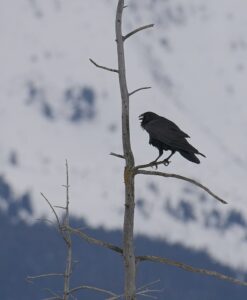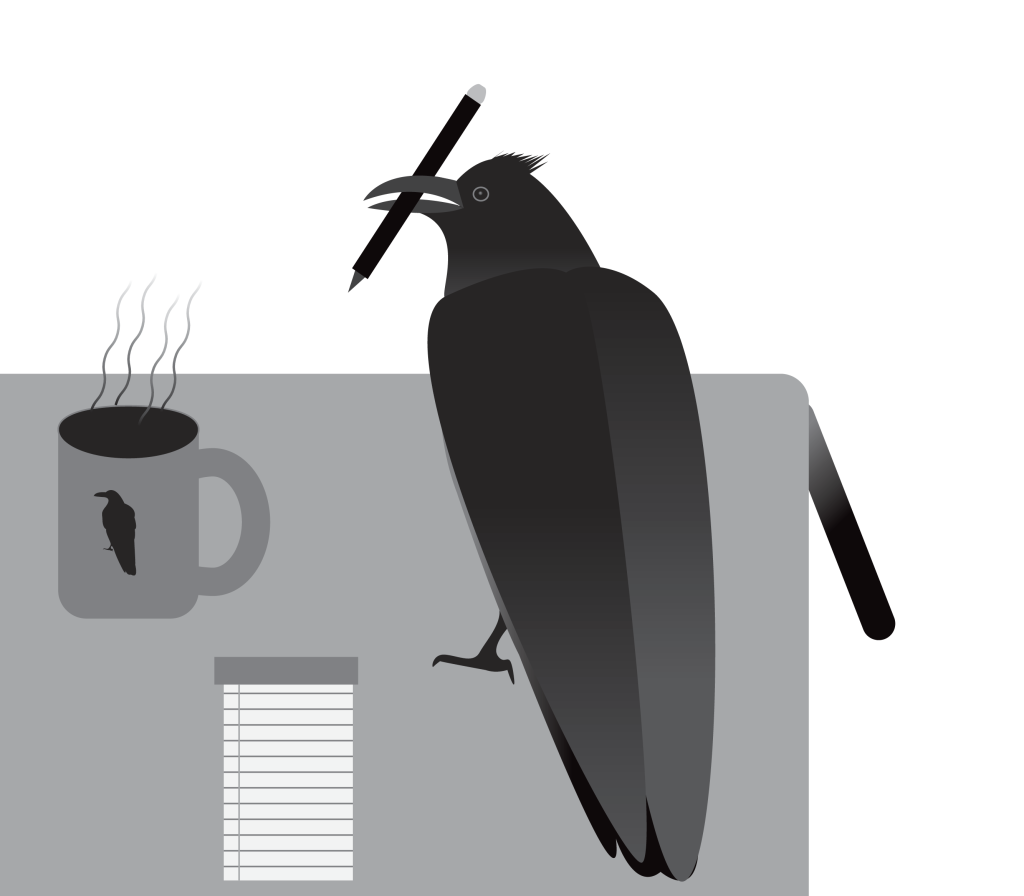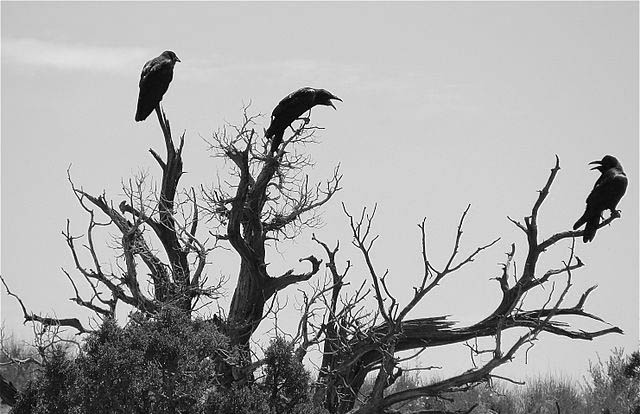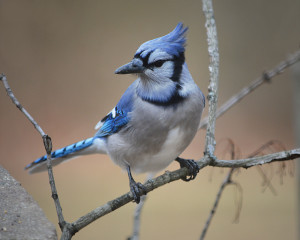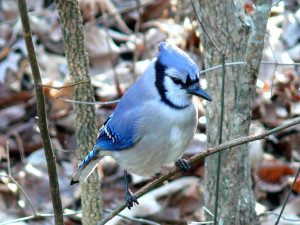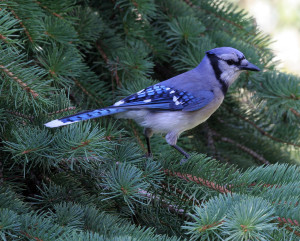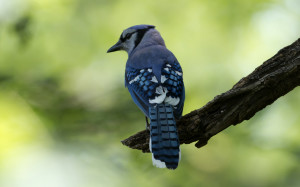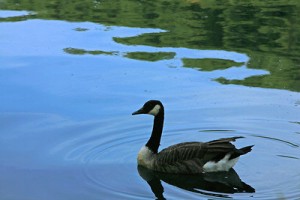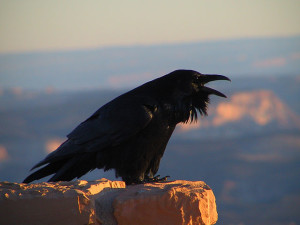
The following is an excerpt from my book-in-progress about animal divination.
Despite being extremely social, ravens and crows squabble quite a bit between themselves, fighting over food and territory. They even, rarely, perform “executions,” a practice poorly understood though well documented. Corvids do not routinely harm members of their posse who are ailing and will even protect the disabled and bring them food. The dominant theory is that solitary birds with no allies eventually excite territorial instincts. Whatever the reason, the flock becomes very noisy as a number of birds execute the offender. Once killed, the cacophony abates suddenly and the birds abscond, leaving behind the corpse.
More common than executions of their own kind is mobbing of raptors. Any songbird might take part in a mobbing, but jays and crows are the most enthusiastic, while the larger and less vulnerable ravens seldom bother. Ravens do buzz and snap at eagles, perhaps to draw eagles away from nest sites (although this does not totally explain things). Some ravens hang out around wolf packs, waiting to devour leftovers from a carcass. In the meantime they enjoy teasing the wolves, pulling their tails and scampering off.
The raven-wolf pairing is more conspicuous in Germanic lore than the raven-horse, although both can be found. Two wolves sit at the feet of the god Odin, while two ravens flank his shoulders. The names of these ravens are Huginn and Muninn. usually translated as “thought” and “memory.” Odin the Allfather “sends them out at daybreak to fly over the whole world, and they come back at breakfast-time; by this means he comes to know a great deal about what is going on, and on account of this men call him the god-of-ravens.” There is some controversy over the meaning of “Muninn,” who is mentioned less frequently than his sidekick in extant Germanic lore. Two questions not entertained, to my knowledge, would be 1) Are these ravens really guy-ravens or is this a case of default male bias? and 2) Why two ravens?
The gender of the ravens does matter, since ravens are Odin’s servants and the Valkyries called the daughters of Odin, serve him on the battlefield as well as in Valhalla. In the Poetic Edda the battlefield is referred to as “Huginn’s grove,” so one or both of these same ravens are hovering alongside the fight like the Valkyries. Perhaps Huginn and Muninn are the culmination of a process from a dominant raven-goddess to a raven-goddess subsumed under rule of the Allfather to a subordinate raven deity stripped of feminine association.
That two wolves and two ravens flank Odin is curious. Why not one raven-wolf pair? Why not nine ravens? Two is not an automatically recurring number in Norse lore; nine, and occasionally three, are the most prominent numbers. If this were a story of Semitic origin I would attribute the pair of ravens to cultural emphasis on complementary halves, but that is not the case here. When Odin says he has two ravens, he means that the ravens are two, and we do have to ask, why two?
The idea that the mind of the God is divided into thought and memory is suspect, since this is a dualistic concept that, if it existed at all, would most probably have arisen through Christian influence. The translation of Muninn’s name as “memory” is contested anyway. There are marriages between gods and goddesses, which might explain the raven-pair, though marriages are often ways of blending the pantheons of conquerors with those of indigenous people, so a marriage might not fit with the idea of the ravens as vestiges of an earlier matriarchal cosmology. There are other deities that are commonly thought of in pairs, such as the goddess Frigga and her son Baldur, and the boar-goddess Freya with her boar-brother Freyr. Could Odin’s winged familiars be brother-sister raven deities?
Where the number two arises most frequently is in reference to the Aesir and Vanir, the two branches of pantheons that came together under the reign of the Odin. Feminist scholars theorize that these groups represent an indigenous Old European pantheon (the Vanir) linked to a conquering Indo-European pantheon (the Aesir) . We could also call them two allied Indo-European pantheons – the point is that they represent the confederation of two tribes. This would explain why Odin has two ravens and wolves at his command: they represent the raven-wolf totems of each of these tribes. This is supported by Odin’s revelation in the Prose Edda, “Over the world every day fly Hugin and Munin; I fear that Hugin will not come back, though I’m more concerned about Munin.” To me this speaks of a ruler trying to maintain control of an unruly alliance.
Sources
The Elder Eddas of Seamund Sigfusson, Benjamin Thorpe, trans, (London: Norroena Society) p. 143. Accessed at Project Gutenberg http://www.gutenberg.org/files/14726/14726-h/14726-h.htm February 22, 2016.
Marija Gimbutas, The Living Goddesses, (Berkeley, CA: University of California Press, 1999), p. 191.
Snorri Sturlson, The Prose Edda of Snorri Sturlson: Tales from Norse Mythology, Jean I. Young, trans. (Berkeley, CA: University of California Press, 2001), p. 64.
